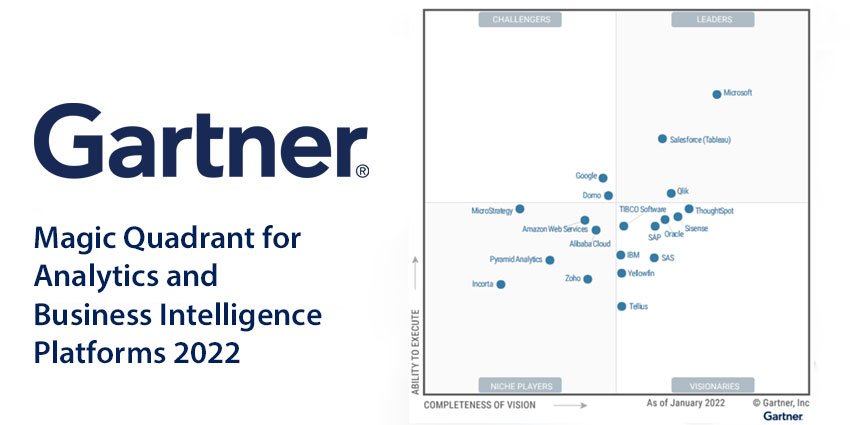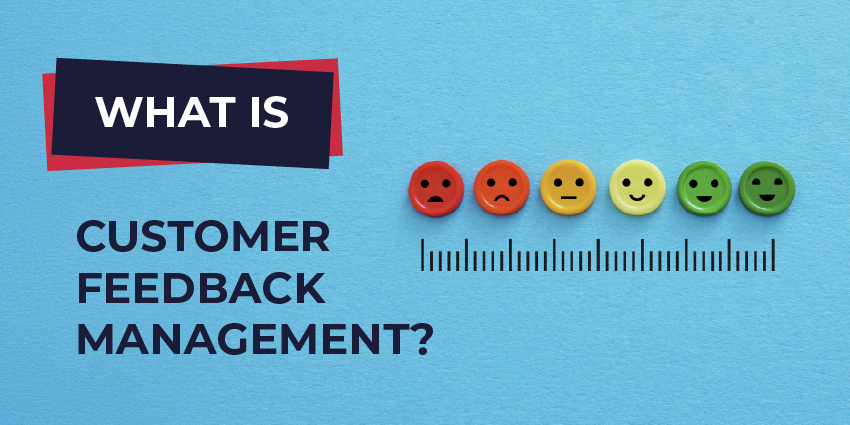Leading research firm Gartner has published its much-anticipated 2022 Gartner Magic Quadrant for Analytics and Business Intelligence Platforms.
As enterprise connectivity and collaboration become more prominent themes throughout the CX space, demand for such solutions is increasing.
After all, not only do analytics and business intelligence solutions uncover hidden insights across the enterprise, but they help to create a unified view of CX. As such, they enable each department to sing from the same hymn sheet.
However, there are many more facets to the platforms provided by the vendors in the magic quadrant. To get to grips with these, here is how Gartner defines such a solution.
The Definition of Analytics and Business Intelligence Platforms
According to Gartner, analytics and business intelligence (ABI) platforms enable less technical members of a CX team to “analyze, explore, share and manage data.” The platform also allows users to uncover and visualize insights while providing a foundation for cross-function collaboration.
AI enables much of this functionality within modern systems, making information relevant to the user and their workflows, as well as easily accessible.
However, there are many more critical capabilities to consider before investing in an ABI platform. Gartner highlights the following 12 as prime examples:
- Security
- Governance
- Cloud-enabled analytics
- Data source connectivity
- Data preparation
- Catalog
- Automated insights
- Data visualization
- Natural language query
- Data storytelling
- Natural language generation
- Reporting
These capabilities are fundamental sources of differentiation between the propositions of the 20 providers below. By assessing each of them closely, Gartner has separated each vendor into four categories: leaders, challengers, visionaries, and niche players.

The 2022 Analytics and Business Intelligence Platforms Magic Quadrant Leaders
Demonstrating an advanced knowledge of crucial ABI capabilities, alongside a commitment to client success, leaders in the magic quadrant pair a robust vision with a track record of delivering value. Not only do they offer proof of this value, but they enable incremental purchases and enterprise scalability to cater for the specific needs of companies across many sectors. This year’s leaders are:
- Microsoft
- Salesforce (Tableau)
- Qlik
Microsoft
Achieving massive market reach and momentum, Gartner praises the Microsoft Power BI offering for its alignment with Office 365, Teams, and Azure Synapse. Such a broad portfolio – which includes visual-based data discovery, augmented analytics, and interactive dashboards – demonstrates a comprehensive vision and ambition. Alongside this, the market analyst also highlights the price and value of the Microsoft solution as a significant differentiator.
Salesforce (Tableau)
After acquiring Tableau in 2019, Salesforce cemented its position as a leader within the ABI space. The acquisition enables Salesforce to build an ecosystem that harnesses all the benefits of MuleSoft, Tableau, and Tableau CRM. In the report, Gartner commends Salesforce for this, alongside its ease of use and analytics economy, allowing users to more easily “access, prepare, analyze and present findings in their data.”
Qlik
2021 was a big year for Qlik, acquiring NodeGraph and Big Squid to add further capabilities to its extensive portfolio. Gartner lauds these additions, pinpointing new machine learning and metadata management features of the Qlik Sense as differentiated strengths. Others noted by the market analyst include the flexibility of deployment that the vendor offers, as well as its customer engagement and data literacy programs.
The 2022 Analytics and Business Intelligence Platforms Magic Quadrant Challengers
Well-positioned to succeed in the ABI market, challengers in the magic quadrant offer a proven ability to continuously deliver value for businesses with specific use cases. However, these providers seem to lack coordination across various products in their portfolios. Alternatively, they may fall behind leaders in regards to sales and marketing, industry-specific content, and innovation. This year’s challengers are:
- Domo
Google has made an impressive entrance into the ABI field since acquiring Looker in 2019. Integrating the ABI platform into its Google Cloud Platform (GCP) ecosystem, Gartner applauds Google for the opportunities to combine its power with other capabilities within its cloud stack. Its in-database architecture and governance – alongside application development resources – are also notable strengths. Yet, the market analyst does warn that SQL skills are required for advanced users.
Domo
According to Gartner, Domo has achieved significant momentum within the crowded space. It notes the provider’s fast speed to deployment and intense consumer design focus as substantial reasons for this, as the company looks to take advantage of the low-code/no-code revolution that is impacting choices of enterprise technologies. Yet, Gartner hints that the company trails market leaders due to its lack of broader application ecosystem channels.
The 2022 Analytics and Business Intelligence Platforms Magic Quadrant Visionaries
Offering a differentiated, robust vision for the modern ABI platform, visionaries in the magic quadrant provide high functionality in their specialist areas. Unfortunately, despite this thought leadership, they sometimes lack the broader capabilities to execute an ABI solution at scale and consistently. This year’s visionaries are:
- ThoughtSpot
- Sisense
- Oracle
- SAP
- TIBCO Software
- SAS
- IBM
- Yellowfin
- Tellius
ThoughtSpot
Introducing a new “developer playground” in 2021, Thoughtspot offers the tools for companies to build innovative data apps. This is just one example of how the company brings its consumer-centric vision to life, which receives significant praise from Gartner within the report. Other noted strengths are scalability and market recognition as an augmented analytics platform. With that said, the research firm does caution that Thoughtspot lacks the broader data and analytics ecosystem.
Sisense
Having recently rebranded its ABI offering as Sisense Fusion, Sisense has evolved its vision – which receives acclaim from Gartner. Such a vision hinges on the vendor’s microservices-based architecture, which is fully extensible. Its development of a unique “multipersona platform” is also a significant strength. Yet, the market analyst encourages Sisense to build into more sectors – alongside manufacturing – for which it differentiates from leaders such as Microsoft and Tableau.
Oracle
Adding Cloud Coach and Code Innovate to its Oracle Analytics Cloud (OAC), Oracle has worked hard to maximize the effectiveness of its platform to pave the way for co-innovation with clients. Such tools enable a consumer-focused product vision – for which Oracle receives special recognition within the report. Its augmented analytics capabilities across its cloud offering also differentiate the solution. However, Gartner highlights its momentum within a busy market as a concern.
SAP
In 2021, SAP prioritized increasing the ease at which users can utilize its ABI solution SAP Analytics Cloud. In doing so, it streamlined the experience of users that switch to its Data Warehouse Cloud. Its success is perhaps evident in Gartner praising the company for its “unmatched” connectivity, alongside its augmented capabilities and closed-loop analytics. Nevertheless, the research firm warns that the adoption of SAP Analytics Cloud is low amongst enterprises that do not harness SAP solutions elsewhere in the company.
TIBCO Software
Building on its machine learning and data democratization features, advanced data preparation and predictive modeling has become a significant strength of TIBCO Software. Gartner notes this while lauding the vendor for its cloud flexibility, enterprise readiness, and roadmap for data and analytics convergence. Unfortunately, TIBCO Software perhaps trails market leaders in its product gaps, such as the lack of ability to build automated data stories from automated insights.
SAS
Launching SAS Viya 4 in 2021, SAS receive special recognition from Gartner for its “market-leading” data visualization. The market analyst also notes that the provider offers a “compelling product vision” for preparing and visually analyzing data, as well as building, operationalizing, and managing AI-powered data science models. However, Gartner questions the limited adoption of the SAS solution and its bundled pricing model.
IBM
Yet another household name making waves within the ABI space is IBM, earning praise for its breadth of use cases, flexible deployment options, and roadmap for applying analytics elsewhere within the enterprise. The latter is particularly interesting as the provider unifies resource planning, reporting, and analysis in a central portal. Yet, according to Gartner, where IBM falls behind is in its lack of sales adoption drivers and pricing versus its cloud competitors.
Yellowfin
Offering a cloud-agnostic architecture, Yellowfin gains lots of business through partnerships with independent software providers eager to embed analytics across their enterprise applications. Such openness – and integrations with each market leader – is a significant strength of the platform, in addition to its customer-centric vision and composability. Its limited geographic reach and market momentum, however, seem to hold the vendor back from leadership status.
Tellius
Empowering users with a “What?”, “Why?”, and “How?” style interface, Teliuis differentiates its ABI offering. Its support for multiple personas, time to value for augmented analytics, and scalability of cloud ecosystems receive acclaim within the report. However, the market analyst does pinpoint possible areas for improvement – highlighting gaps in its use of data storytelling and reporting, as well as its lack of availability to third-party resources.
The 2022 Analytics and Business Intelligence Platforms Magic Quadrant Niche Players
Often achieving positive results across specific sectors or use cases, these vendors can provide the ideal solution to enterprises that harness a particular cloud stack. Yet, Gartner questions its ability to compete with market leaders – in terms of both innovation and performance. This year’s niche players are:
- Amazon Web Services
- Alibaba Cloud
- Zoho
- Pyramid Analytics
- MicroStrategy
- Incorta
Amazon Web Services
In recent times, Amazon Web Services (AWS) has taken a big step forwards into the augmented analytics space, adding Q – a natural language query capability – to its Amazon QuickSight solution. The solution tightly integrates with AWS and is highly scalable. Yet – despite its high brand familiarity – customer adoption remains slow. Gartner highlights this while hinting that the company should perhaps prioritize the development business application ecosystem.
Alibaba Cloud
As a major player in the Asia/Pacific territory, the Alibaba Cloud Quick BI platform is futuristic in its approach to collaborative analytics and digital workplace orientation. Its data literacy program and composable analytics capability – which helps to automate business workflows – also earns praise from Gartner. However, the market analyst pinpoints a lack of investment in BI – as compared to its other focuses – as a caution.
Zoho
Well known for its CRM platform, Zoho also boasts an ABI platform – Zoho Analytics – that offers advanced data preparation, visualization, and embedded analytics capabilities. Yet, Gartner notes its Natural language query functionality as a strength that differentiates its offering. Holding the solution back, however, is a limited product vision and product gaps. The market analyst notes the absence of visual interactivity, such as brushing and lassoing, as a significant example of the latter.
Pyramid Analytics
Gartner notes a plethora of strengths within the Pyramid ABI solution, including a breadth of use cases, comprehensive deployment options, and augmented analytics capabilities. This final strength is largely due to its refined automated insights and Smart Discover framework. Nevertheless, the provider seemingly lacks the clear cross-sector strategy, market traction, and third-party resources and skills to compete with more recognizable brands.
MicroStrategy
The Magic Quadrant report states that: “MicroStrategy excels at scalability, manageability, and security desired by IT.” Gartner notes that its unique Mode 1 reporting and Mode 2 analytical environment is a significant enabler for these strengths. Unfortunately, the market analyst cautions that a lack of surrounding data or application ecosystem and feature gaps within its augmented analytics capabilities hold back the MicroStrategy ABI platform.
Incorta
Providing neatly packaged analytics applications across several systems, including NetSuite and Salesforce, Incorta excels in lowering the time to insight for users. Its Direct Data Mapping (DDM) functionality paves the way, eliminating the effort associated with data extraction, transformation, and loading. Nevertheless, Gartner refers to its Incorta Cloud offering as “immature” while highlighting that the vendor lacks augmented analytics features.
What Do You Think Of the Results?
Despite the number of major brands included in the magic quadrant – including Google, AWS, and IBM – Gartner named only three market leaders: Microsoft, Salesforce (Tableau), and Qlik.
Yet, looking at the graph, Microsoft currently leads the way, and Gartner notes that the company “dominates the market in terms of user adoption.”
With lots of competition, however, companies can perhaps expect to see significant disruption across the space throughout the rest of the year.
Given this – as well as the prominent providers not included within this edition, such as Teradata, it will be fascinating to see how the 2023 Analytics and Business Intelligence Platforms plays out.
Learn more insights from Gartner regarding analytics service providers by reading our rundown of the Gartner Magic Quadrant for Data and Analytics Service Providers 2022







